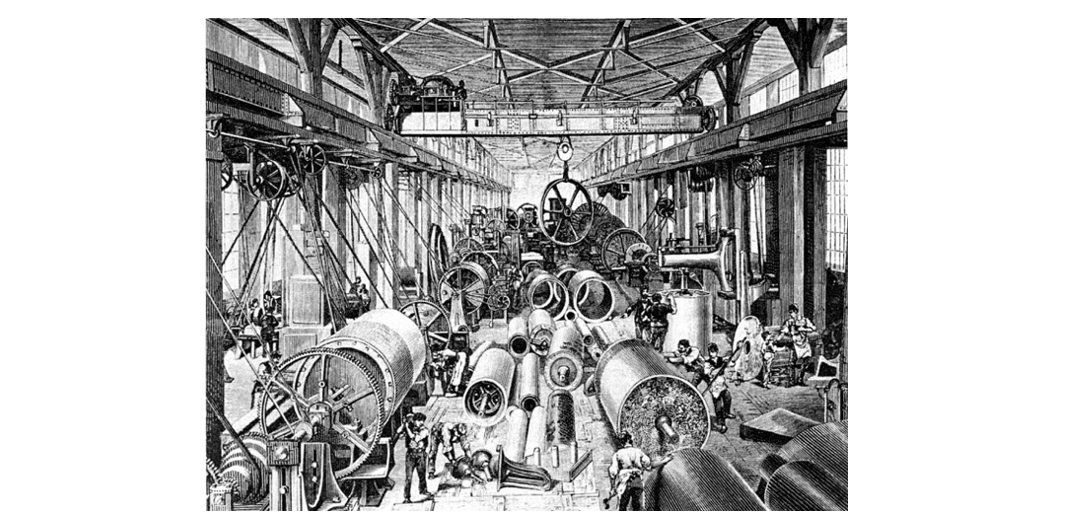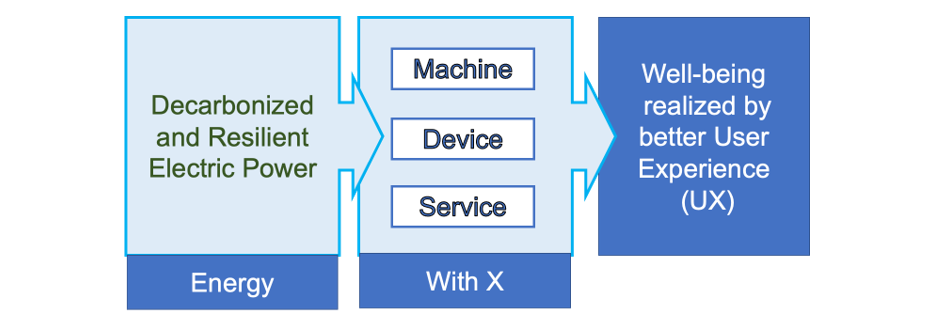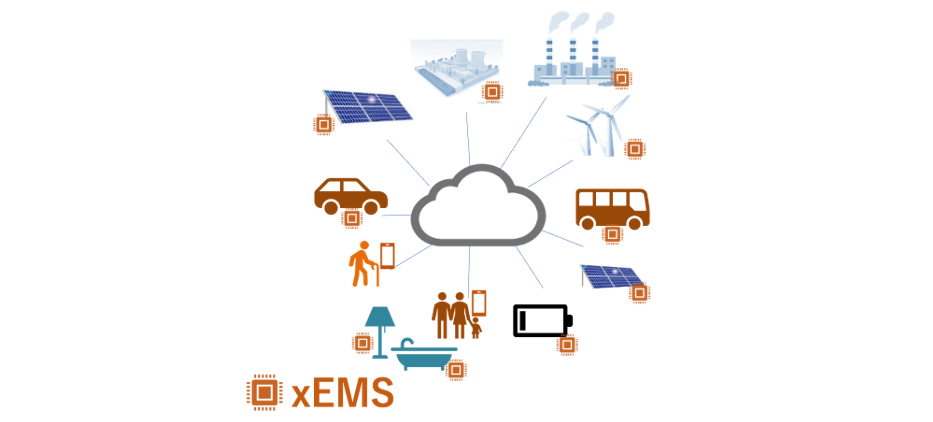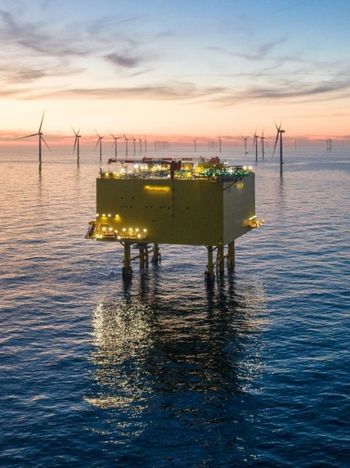The Fourth Industrial Revolution Empowered by End-to-End Electric Power System
In the April issue of ELECTRA, I described "Challenges in Japan's Energy Systems to Achieve Carbon Neutral and Resilient Communities"[1]. In the present article, as a sequel to the previous one, I continue to look back at the history of the energy and industrial revolutions from a bird's eye view and envision the coming 4th Industrial Revolution. The starting point of the Fourth Industrial Revolution is the development of AI and big data, and I will clarify that its social implementation will require the integration of decentralized electric brain, decentralized mechanical power produced by motors, and decentralized electric heat with decentralized and renewed end-to-end electric power systems. Finally, I will describe the expectations of CIGRE, the global community of electric power systems experts, on how it should contribute to the Fourth Industrial Revolution.


by Chief Technical Officer, TEPCO Power Grid
History of Industrial Revolutions and Energy

Figure 1 - History of Industrial Revolutions and Energy
Humans began using fire more than a million years ago. In the 18th century, with the invention of James Watt's steam engine, machines replaced human power and horsepower by using the steam energy generated by burning coal to move pistons and transmit that power. It was the first industrial revolution. But burning fuel inevitably produces CO2.
The Second Industrial Revolution saw the advent of electricity. Mass production in factories became possible, and a typical example is the emergence of the Ford Model T. With motorization, the main fossil fuel gradually shifted from coal to oil, but two oil shocks promoted alternative energies: natural gas, renewables, and nuclear power.
The Third Industrial Revolution was the so-called "information revolution," in which electronic computers began to automate various processes, and this continues to this day with the remarkable development of the Internet.
On the other hand, when it comes to energy, the goal is to decarbonize in the 21st century. The energy transition means "reinventing fire," which is no easy task. Specifically, the physical world will be powered by carbon-neutral electricity from renewable and non-fossil energy sources such as nuclear power. Some processes are also expected to use green hydrogen and ammonia produced from these types of electricity, but the focus will be on electricity.
Let us look at the above story in more detail. Fig. 2 shows the inside of a factory after the First Industrial Revolution, circa 1875. On the right side of the factory is what appears to be a steam engine piston. The factory is full of shafts, gears, and belts to move this mechanical power around the factory. It looks very unproductive and must have been dangerous. In other words, there was a single large source of power in the factory, and the power was transmitted through this mechanical network, which was very inconvenient.

Figure 2 - Factory mechanized by steam engine in 1875 [2]
Compare this to the Ford factory of the 1930s, shown in Figure 3. In Figure 3, the factory is orderly. What happened? Ford's invention was mass production by conveyor belt, using electric motors. Unlike steam engines, motors do not lose efficiency as they get smaller, so the mechanical power source is distributed and used to move the conveyor belts. In this way, the conveyor belts could be laid out freely to increase productivity in the factory. This is the second industrial revolution through electrification. It means that a single mechanical power source and mechanical transmission network in the factory has been replaced by decentralized motors and a power network within the premises, distributed and arranged by electrification.

Figure 3 - Ford's factory after the Second Industrial Revolution (1930s) [3]
Interestingly, there was a 25-year gap from the time Edison started his first electricity business to get to this point. According to Matthew Syde, the truth is that most managers at the time apparently assumed that there was only one source of mechanical power in the factory and did not pursue electrification because they thought that even after the advent of electricity, simply replacing the steam engine with a large motor would not increase any productivity in their factories. In ref [6], Mcafee and Brynjolfsson write, "Electrification was one of the most disruptive technologies ever; in the first decades of the twentieth century, it caused something close to a mass extinction in US manufacturing industries. ".
How was the electricity supplied for the motors in the Ford factory? Upstream of the factory, innovations in power supply were taking place. Samuel Insull would take electric power to a larger scale by using alternating current, invented by Nikola Tesla and promoted by Westinghouse, instead of Edison's direct current. AC made it possible for the first time to scale the electrical grid.
Economies of scale drove down costs, and the electric utility business took off. A centralized electric utility business model was created in which electricity was delivered to customers from large power generation facilities over an extensive power grid. This business model was so superior that it has endured for more than 100 years.
What happened downstream from the Ford factory? Mass production of the Ford Model T began in 1908. It used an internal combustion engine as its mechanical power source. By this time, electric cars had been invented, and the first car capable of traveling over 62 mph (100 km/h) was built in 1899. However, the electric cars were overwhelmed by the Model T and disappeared from history for the time being because of their short range. It can be said that this was the beginning of the mass consumption of gasoline.
Something else happened. Today we assume that a car has a single internal combustion engine and four wheels. A mechanical transmission connects the single combustion engine to the tires that need mechanical torque. This system is also wonderful, and since it has been in place for over 100 years, it is the norm for us, but it can also be called a centralized system.
In summary, it is very interesting to note that while decentralization of mechanical power occurred in the Ford plant, centralized systems spread upstream and downstream of the plant.
The Reality of the Fourth Industrial Revolution
I envision the energy world shifting to a Utility 3.0 world[4]. There are three key points: the first is the shift to a society that uses renewable energy more efficiently, the second is the need for customer-driven change, and the third is the convergence of infrastructures.
First, as mentioned in the previous paper, a major challenge in the mass introduction of renewable energy is the spatial and temporal gap between power generation and power consumption.
To address this challenge, Japan's Transmission System Operators (TSOs) are currently promoting wide-area operation of their power systems and TSOs are working on the implementation of a jointly owned "control centers as a service" that will optimize supply and demand in the nation bulk transmission network at large, with a target year of 2028.
The next thing I would like to point out is the concept of "Energy with X" (energy is with all industries and human beings). Energy supply is very important, but we must first return to the goal of bringing wellbeing through better user experience (UX). It is the machines, devices and services that provide the better UX, and energy is provided only as an intermediate good. We need to think of everything from the user's point of view and from a human-centered perspective. The energy needed for this must be carbon neutral and resilient, and the matching of power sources and demand will become an increasingly important issue as distributed renewable energy increases. In other words, interactive energy management technologies are needed.

Figure 4 - Energy with X
Third, energy, information and mobility infrastructures are beginning to converge: EVs travel on the transportation network of roads, but they can also be said to travel on the electricity network through charging stations. In an emergency, the electricity from EVs will be useful. In this case, the roads are used instead of the electricity grid. In addition, a communications network is needed to operate these systems. High-speed wireless communication such as 5G will be used for automation of the real world in earnest in the future, and the antennas and base stations for this may be installed using the power infrastructure such as utility poles, transmission towers, and substations. Therefore, it is necessary to consider these as an integrated infrastructure, rather than as separate networks.
Now, let us consider the Fourth Industrial Revolution that will occur because of AI x Big Data. In Japan, the fourth industrial revolution is called "Society 5.0," and both are based on the idea of highly integrating cyberspace and physical space. Cyberspace is driven by the electric brain, while physical space, which is electrified by carbon neutral energy, is driven by electric motor and electric heat.
Let's take them one at a time. The electrification of vehicles is not only a big issue for carbon neutrality, but they will also be connected and controlled by software, which means software defined. For example, some EVs are already software-defined, with firmware updates over the cellular network, additional services, recalls, and so on.
By the way, most EVs today still have "single electric motor and four tires in the body". Since motors can be miniaturized and still provide high performance when decentralized by using them as in-wheel motors, they only need to be connected by electrical wires instead of a mechanical network. Therefore, it will be possible to freely create vehicles of any shape for any purpose. In addition, propeller blades can be driven to fly in the sky. In other words, it will be a mobile robot that is automatically driven by using AI and 5G technology. I am not sure if we can call them cars or not, but the trigger for this dramatic change is the advancement of battery technology.
A similar change will occur regarding heat demand. All large boilers and heating systems in factories will be electrified and distributed as heat source equipment such as heat pumps and induction heating. This will replace heat networks such as steam and hot water pipes with electric wires, and the decentralization of heat sources will enable the supply of heat at the optimum temperature for individual heat demand.
Finally, I would like to describe the electric brain that dominates cyberspace: as we enter the world of AI x big data and the explosive growth of data volume, the power consumption of digital infrastructure such as data centers is rapidly increasing due to the advancement of AI x big data. According to the assumptions of the Center for Low Carbon Society Strategies of the Japan Science and Technology Agency, data center power consumption in Japan will be 14TWh in 2018, but if current technology continues, it will reach 90TWh in 2030 (10% of domestic power consumption) and 12,000TWh in 2050 (more than 12 times the current power consumption). It will be distributed not only in hyperscale data centers, but also at the edge, and local production and consumption of information will also increase.
As mentioned in the previous article [1], in the human body, there is a close relationship between the nervous system, which controls the information, and the vascular system, which delivers oxygen needed for physical movement. In addition, since the human brain consumes 25% of the total body oxygen, it is analogous to the fact that in Society 5.0, even if the volume of data increases explosively, energy consumption in data centers will need to be kept to about one-fourth of the total.
As with the human body, the complementary nature of fiber optics and wires should also be exploited. For example, if we bring electric brains to the renewable energy-rich countries to cover the electric demand needed in Japan and enhance global optical fiber to transmit data for this purpose, it is identical as carrying decarbonized energy from renewable energy-rich countries. Keep in mind that high-capacity fiber optic cables are about 1/100th the weight and installation cost of HVDC power cables. Shifting computational loads between remote data centers can instantly move where power is consumed.
Some applications require low latency, while others can be pre-computed. For those that can be pre-computed, computing them ahead of time and storing them in memory has the same effect as shifting the time of electricity use.
If these technologies become common, the generation surplus of renewable energy can be stored not as electricity or hydrogen in physical space, but as monetary value such as bitcoin or wisdom such as AI's pre-training in cyberspace.
In summary, the Fourth Industrial Revolution of AI x Big Data will be implemented in society only by integrating the decentralization of electric brain, electric motor, and electric heat with decentralized electric power systems. I believe this revolution has already begun.
Driving an Industrial Revolution in the Rural Areas

Figure 5 - A farm using solar sharing in Chiba, Japan, with its CEO, Dr. Magami, and the author
Fig. 5 shows a farm-based photovoltaic generation system, so-called 'solar sharing', operated by Chiba Ecological Energy Inc. You might think that if PV panels are installed on top of farmland, farming would be unsatisfactory. However, if the panels are optimally placed, as shown in this photo, the farmland is bright enough, frost-free, and free from damage caused by strong sunlight. There is also a synergy in that the vapor from the crops cools the solar panels, thereby increasing the amount of electricity generated.
The electricity generated here can be used to electrify and automate the mechanical power needed for agriculture with storage batteries. Perhaps drones, 5G, and edge data centers should also be utilized for the automation of agriculture.
Furthermore, the electricity produced by solar sharing cannot be used up by agriculture alone. In fact, just by converting 5% of the nation's arable land to farming type, about 200 billion kWh of electricity could be generated annually in Japan. Therefore, if we build a food processing plant nearby, use the surplus electricity, and utilize decentralized electricity and heat in the plant, a processing industry based on agricultural products can be established. If we want to send out processed products, we need logistics. These logistics will naturally be electrified and automated.
In addition, in rural areas, where it is difficult to secure transportation such as railroads and bus routes, we can operate EV buses that are automatically driven by solar-shared electricity. This would be a great help in improving the resilience of the community. Resort development in the form of Agri turismo is also a possibility. Electricity that is still not used up will be used for distributed computing including bitcoin mining or transmitted to metropolitan areas.
End-to-End Electric Power Systems and CIGRE's Role
To realize the industrial revolution described above, it is important to design the electric power system based on the same "end-to-end" principle as the Internet. The end-to-end principle of the Internet means that advanced communication control and complex functions are performed by the terminal, while the system along the path simply relays and transmits signals and data. In other words, the terminal side is made intelligent and combined with a dumb network. The reason for this is that making the terminal side intelligent has allowed a variety of ideas to be combined and innovation to progress at an overwhelming speed, while making the network intelligent has inevitably led to centralization, which has prevented innovation from progressing.

Figure 6 - End-to-End Electric Power Systems (See the article [1] in the detailed diagram)
In this way of thinking, in the electric power system as well, distributed energy resources and customer-side energy devices at the grid edge should be equipped with an EMS to adjust the supply-demand balance and congestion of power flow. As shown in the figure, an EMS is built into every grid edge, and the overall supply-demand balance, and power flow will be controlled through information exchanges between EMSs (the market is also considered to be one of the EMSs). The convergence of the Internet and the electric power system will complete the infrastructure known as the "Internet of Functions" in Japan[7].
There is various information that can be exchanged between EMSs, but it is effective to use "price signals" that can reflect supply-demand balance and congestion within the grid. At the same time, "end-to-end security" is needed to ensure cyber security and protect the privacies of users.
CIGRE is a global community of experts dedicated to innovating end-to-end electric power systems. The 4th Industrial Revolution, as described in this paper, will be caused by the convergence of the end-to-end electric power system and the Internet, and the role that CIGRE should play in the 4th Industrial Revolution also be obvious. The CIGRE's role is to contribute to the human centric Fourth Industrial Revolution by bringing together diverse global knowledge on electric power systems and integrating them.
I would like to thank my many friends for their valuable discussions in compiling this manuscript and AI for revising the manuscript on behalf of the author, whose English is not very good.
References
- Hiroshi Okamoto, "Challenges in Japan's Power Systems to Achieve Carbon Neutral and Resilient Communities", ELECTRA N°327 - April 2023
- [Link]
- [Link]
- Hiroshi Okamoto, "Utility 3.0: Japan’s Utility of the Future", ELECTRA N°311 - August 2020
- Matthew Syde, 'Rebel Ideas: The Power of Thinking Differently', John Murray, June 2021
- Andrew Mcafee, Erik Brynjolfsson, 'Machine, Platform, Crowd: Harnessing the Digital Revolution: Harnessing Our Digital Future', June 2017
- Hiroshi Esaki, 'Cyber First: Reverse Economy of Digital and Real Worlds', June 2017 (in Japanese)
Banner & thumbnail credit: generated by IA



